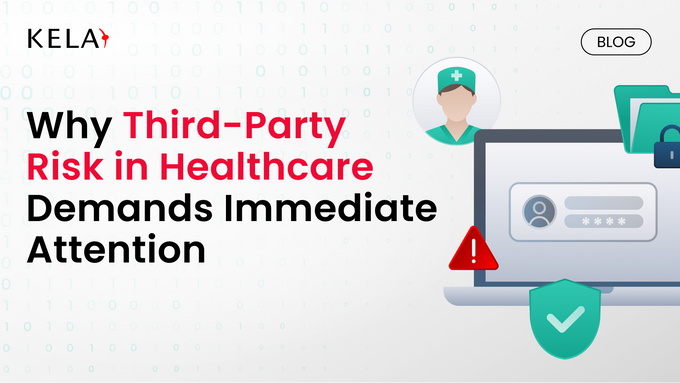Why Third-Party Risk in Healthcare Demands Immediate Attention
Third party risk in healthcare is no longer just a compliance concern but a direct threat to patient safety, data privacy, and operational continuity. As healthcare organizations increasingly rely on vendors for critical services, attackers are exploiting these third-party connections as weak entry points, leading to costly breaches and service disruptions.
Published August 16, 2025

Healthcare organizations rely on an ever-expanding network of third-party vendors; from cloud service providers and EHR platforms to billing processors and medical device manufacturers. While these partnerships drive efficiency and innovation, they also introduce serious cybersecurity and compliance risks.
Third-party risk in healthcare refers to the vulnerabilities and potential damage that external vendors can introduce to a healthcare organization’s IT environment, operations, and most critically, patient safety.
In recent years, attackers have increasingly targeted healthcare vendors as soft entry points. One compromised supplier can open the door to HIPAA violations, data breaches, and life-threatening system outages.
According to IBM’s 2023 Cost of a Data Breach Report, the average healthcare breach now costs $10.93 million—the highest across all industries.
As healthcare continues to digitize, third-party risk management (TPRM) is a strategic necessity as it proactively protects patients, reputations, and regulatory compliance adherance
The Healthcare Sector's Unique Risk Landscape
The healthcare industry operates within one of the most complex and sensitive digital ecosystems. Unlike other sectors, healthcare organizations manage not only financial and operational data but also protected health information (PHI), which is highly valuable on the dark web.
Why Healthcare Is a High-Value Target
- PHI is worth more than credit card data on black markets.
- Hospitals and clinics often rely on legacy systems that lack modern security controls.
- Many healthcare providers operate under tight resource constraints, delaying critical security upgrades.
- The adoption of IoT devices and Telehealth has expanded the digital footprint dramatically.
The Web of Third Parties
Modern healthcare delivery involves a vast network of third parties:
| Vendor Type | Common Examples | Potential Risks |
| Cloud Service Providers | AWS, Azure, Google Cloud | Misconfigured storage exposing PHI |
| EHR Vendors | Epic, Cerner, MEDITECH | System outages or data access vulnerabilities |
| Billing & Revenue Partners | Claims, processors, coding services | Payment fraud or PHI leaks |
| Medical Device Suppliers | Connected diagnostic or therapeutic devices | Firmware vulnerabilities, data leaks |
| SaaS Applications | Scheduling, patient engagement tools | API vulnerabilities or improper data sharing |
As digital health ecosystems grow, every third-party connection becomes a potential attack vector. Without structured TPRM, healthcare organizations remain blind to these hidden entry points.
What is Third-Party Risk Management (TPRM)?
Third-party risk management (TPRM) in healthcare is the structured process of identifying, assessing, monitoring, and mitigating risks posed by external vendors and service providers. Its goal is to ensure that third parties do not compromise patient safety, data security, or regulatory compliance.
TPRM is more than just a procurement checklist. It’s an ongoing, organization-wide effort that aligns legal, IT, compliance, and clinical teams to proactively reduce exposure.
The TPRM Lifecycle
A comprehensive healthcare TPRM program follows this lifecycle:
- Vendor Onboarding: Identify vendor type, service provided. and risk level.
- Risk Assessment: Evaluate security posture, data access, and potential risks.
- Contractual Controls: Define SLAs, breach notification terms, and compliance requirements.
- Ongoing Monitoring: Track vendor performance, risk signals, and changes in scope.
TPRM’s Core Objectives
- Secure Protected Health Information (PHI) and other sensitive data.
- Prevent operational disruptions from vendor-related outages.
- Ensure ongoing regulatory compliance with HIPAA, HITECH, and state laws.
- Reduce financial risk from fines, lawsuits, and recovery costs.
- Safeguard patient trust and organizational reputation.
Third-party vendors are implicated in nearly 60% of healthcare breaches, according to the Ponemon Institute.
By embedding TPRM into healthcare operations, organizations reduce blind spots and strengthen resilience against a rapidly evolving threat landscape
Why Third-Party Risk in Healthcare Is a Patient Safety Issue
When most people think of cybersecurity, they imagine data theft or financial fraud. But in healthcare, third-party risk has direct implications for patient safety. A breach, system failure, or delayed access to critical systems can disrupt care, and in some cases, cost lives.
Real Risks to Real Patients
Third-party vendors often operate systems essential to delivering care:
- Electronic Health Records (EHR): A breach or outage can delay diagnoses or treatments.
- Clinical decision support tools: Downtime can impact medication safety or lab result interpretations.
From Compliance to Care Continuity
Traditionally, TPRM was viewed through a compliance lens, focused on HIPAA audits and policy documentation. But today, the conversation is shifting. Healthcare leaders recognize that third-party vulnerabilities can:
- Interrupt life-saving procedures
- Delay access to lab results, prescriptions or imaging
- Erode trust in care providers
- Increase clinical errors under pressure or without data
Regulatory Pressures and Compliance Requirements
Healthcare is one of the most highly regulated industries in the world, and for good reason. The sensitivity of patient data and the consequences of exposure or misuse are too severe to ignore. That’s why third-party risk in healthcare is closely tied to regulatory compliance.
Key Regulations Governing Third-Party Risk
- HIPAA (Health Insurance Portability and Accountability Act): Requires covered entities to ensure business associates (BAs) protect patient data.
- HITECH Act: Extends HIPAA rules to BAs and introduces breach notification requirements.
- OCR (Office for Civil Rights) Enforcement: Audits and penalizes healthcare entities and their vendors for non-compliance.
- State Laws: States like California and New York have stricter breach notification timelines and data protection laws.
The Cost of Non-Compliance
| Violation Type | Potential Consequences |
|---|---|
| Missing or outdated BAA | Up to $1.5M per year per violation |
| Delayed breach notification | Civil penalties and regulatory sanctions |
| Inadequate third-party due diligence | Class-action lawsuits, fines and audits |
Ensuring compliance is about maintaining operational integrity, public trust, and the ability to deliver care without disruption.
Building an Effective TPRM Program in Healthcare
An effective TPRM program in healthcare helps stay ahead of risks that could impact patient care. The goal is to know who your vendors are, what data they touch, and how secure they really are.
Key Elements
- Keep a current vendor list—you can’t secure what you don’t track.
- Group vendors by risk—those handling PHI or critical systems need more scrutiny.
- Assess before onboarding—and reassess regularly.
- Get the right contracts in place—BAAs, SLAs, and breach notification terms.
- Monitor continuously—don’t rely on one-time questionnaires.
How Cybersecurity Platforms Can Help
Managing third-party risk manually, especially across dozens or hundreds of vendors, is time-consuming, error-prone, and reactive. That’s where cybersecurity platforms such as KELA come in.
What a Good TPRM Platform Can Do
- Automate vendor assessments: Send and score risk questionnaires, flag missing controls, and track follow-ups.
- Continuously monitor vendor security: Detect exposed systems, vulnerabilities, or darknet mentions tied to your vendors.
- Provide risk scoring: Prioritize vendors based on actual threat exposure, not just paperwork
Future Outlook: Third-Party Risk in an Expanding Healthcare Ecosystem
Third-party risk in healthcare isn’t going away, in fact, it’s only getting more complex. As the industry leans further into digital transformation, the number of external partners and technologies involved in care delivery keeps growing.
What's Changing?
- Telehealth and remote monitoring are adding more endpoints and third-party tools.
- AI-powered diagnostics and decision support tools often involve external vendors.
- Connected medical devices (IoMT) are expanding the attack surface inside hospitals.
- Healthcare startups and SaaS platforms are increasingly integrated into core workflows.
Each innovation brings value, but also new risks that traditional TPRM methods can’t keep up with.
Why It Matters
- Threat actors are targeting the weakest link, often a third-party vendor.
- Compliance expectations are tightening, with regulations demanding continuous oversight
- Patients expect providers to safeguard their data, no matter who handles it.
Third-party risk in healthcare is growing fast, and so are the stakes. Protecting patient data, ensuring system availability, and staying compliant all depend on how well healthcare organizations manage their vendor ecosystem. A modern TPRM strategy isn’t just about avoiding fines; it’s about safeguarding trust and continuity of care.





